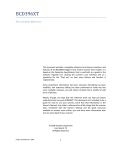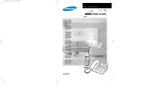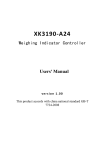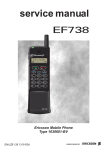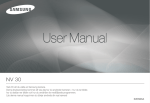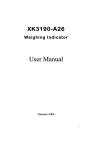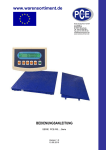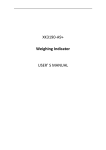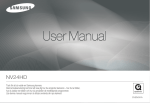Download Epson XK3190-H2B User guide
Transcript
Electronic Crane Scale XK3190-H2B Weighing Indicator USER GUIDE VER 1.02 Shanghai Yaohua Weighing System Co.,Ltd. Version: May,2004 Content I Technical Specification II Configuration, Installation and Application I .Configuration of the scale body II. External layout of indicator III. Wireless working mode IV. Wire working style V. Replacing the printing paper and the ink ribbon of the micro printer VI. External printer installation VII. Communication interfaces VIII. Scoreboard Connection IX. Charge III Keypad Functions I. Keys setting and keypad layout II. Keys functions Ⅳ Data Printing Format I. Micro-printer printing format II. External printer printing format V Error message from wrong operation VI Error message from wrong inner operation VII Trouble Shooting Appendix Attention: Please read the instruction before operating the instrument. I Technical Specification 1. Model 2. Accuracy Division Units of Measure 3. Analogue Conversion Principle Input Signal Range Max Net Input Signal Conversion Rate A/D Conversion Resolution Non-linearity F.S. Temperature Coefficient Calibration Load Cell Excitation Load Cell Drive Capacity Connecting Method of Load Cell Displaying Cycle 4. Clock Accuracy 5. Keypad Digital Keys Function Keys Key Material 6. Scoreboard Interface Transmission Mode Data Type Baud Rate Transmission Distance 7. Serial Communication Interface Transmission Mode Baud Rate Transmitted data format Transmission Distance 8. Printer Port 9. Data Storage XK3190-H2B Meets the regulations of OIML, R76, JJG-555 and national standard of the electronic crane scale. Accuracy - Class Ⅲ From 0.01 to 50, 12 options in total. Verifying division will be set automatically each time when powered on. Usually, the division is supposed not to be modified. 4 options: t, kg, g and mg 24 bit ∑-△ mode, A/D converter -2mV~+18mV 20mV 6.25 times per second 500,000 <0.01%F.S <6PPM/℃ Full digital calibration (FDC) DC 5V up to 4 load cells at 350Ω 4 leads 160ms Displaying Y/M/D, H/M/S and leap year/month ±5s/24h, free from influence of powering off 0~9, ·, 24 (12 overlapped with digital keys) Sealed elastomer Serial output mode 20mA current loop 11 bits 600 ≤2000m RS232C/RS422 (Optional) 600, 1200, 2400, 4800, 9600 10 bit:1 start bit, 8 data bits (ASCⅡ Code), 1 stop bit RS232:≤30m RS422:≤1200m Standard parallel output port 11 categories of weight records, net/gross weight information, weighing time and weighed result can be stored (each category is composed of 99 sets of data), and category identification marks can also be set. 10. Power Supply Power of Indicator Power of Scale Body 11. Signal Transmission Transmission Distance Wireless Frequencies 12. Display Display Cycle 12V/1.6Ah NiCd battery 12V/1.8~2.2Ah NiCd battery or CP7-12 storage battery. wire/wireless 200m (wireless) 50m (wire) 223.300MHz, 224.900MHz, 230.050MHz, 233.050MHz, 234.050MHz in 230MHz BAND; 450.0125MHz, 450.0625MHz, 450.1125MHz, 450.1625MHz, 450.2125MHz in 450MHz BAND. 10 frequencies in total (the number can be increased if necessary) 11 bits LED, LED indicates driving voltages (Brightness):16 degree adjustable, EL background light adjustable. 160ms LoBAT t COMM kg 1×1 mg 2×0.1 shift sum lb ×10 5×0.01 (Figure1)LED sketch map 13. Other Functions 1). Various digital filtering modes are adopted. Displaying stabilizing time: ≤10s during swaying angle≤±2° 2). Non-linearity parabolic modification 3). Auto zero-point and minus tare weight point tracking 4). Tare function: Tare can be weighed or preset. Tare range is set to be between 0-Max. There are different annunciators corresponding to Net Weight, Tare and Gross Weight states. 5). Minus weight function 6). Power-saving function. Entering power-saving mode 30 seconds after weight is stabilized. 1 wireless digital transmission every 5 seconds. Powering off automatically 30 minutes after no any fluctuation in weight. 14. Operating Environment Operating Temperature Indicator: 0℃~40℃ Body: -20℃~40℃ Storing and Transporting Temperature -25℃~55℃ Relative Humidity ≤85%RH 15. Dimension Weight 330 x 230 x 60 (mm) around 1.5kg II Configuration, Installation and Application The wireless electronic crane scale is mainly composed of scale body and indicator, accessories like charger, cable, are also supplied. 1. Configuration of the scale body This part is makes up of weighing load cell, carrier and transmitting mechanism, case, A/D module, wireless digital transmitter, battery, etc. 2. External layout of indicator Micro-printer LCD Screen Keypad Antenna (Figure 2) Front layout Printer Port RS-232/422/485 Scoreboard Interface Signal Cable Power Switch Charger socket Calibration Switch (Figure 3)Rear Wiring Layout 3. Wireless working mode: Usually, XK3190-H2B Indicator is used in wireless transmitting electronic crane scale. Install the transmitting antenna before operation, and then open the small cover on the scale body to install the battery, after inserting battery plug into the battery socket and turning on the switch, the annunciator begin to twinkle, indicating the electric circuitry of the scale body in working state. The crane scale will go into the power-saving mode and twinkle once every 5 seconds when it has been out of operation or the weight on the scale has kept unchanged for 30 seconds. At this time, the scale will go into the normal working condition automatically if the load varies≥0.1%F.S and 0.3%F.S. within one second. The scale will be powered off automatically if the load weight keeps unchanged for 30 minutes. If need to be restarted, turn the power switch off or take off the battery plug, and then turn power switch on or insert plug several seconds later, Note: No keeping battery in scale for a long time without antenna installed, just in case that damages happen to wireless digital transmitter in scale body. 4. Wire Working Style No necessary to install battery and antenna to XK3190-H2B during indicator wire working mode. Weighing operation can be performed after connecting scale body and indicator to the 2 ends of signal cable and turning on the switch. When powered off, press <<Off>> to shut down the indicator first and then cut off the back power switch or take off the wire transmitting cable. The indicator will remain supplying power to scale body and shorten the life of the battery if the back power switch is not off or the cable is not took off. 1 5 4 2 3 1- 12V power 2- Space 3- Signal 4- Space 5- Earthing (Figure 4) Signal cable interface view 5. Replacing the printing paper and the ink ribbon of the micro printer Open the printer cover, press the pothooks on the both sides of printer rack to take the printer off, take out the paper reel (paper is used up) and put a new reel of paper in, cut the paper end into an arch and then push it into the paper feeding slot of the printer, press <<Paper>> to set it into an appropriate position, and close the printer cover. The ink ribbon needs to be replaced when the printed letter became vague. Open the cover of the printer and press the button marked with <<PUSH>> on the ink ribbon, one end of the ribbon will be tilted. Take out the old ribbon and install the new ribbon in a reverse direction, then close the cover. 6. External printer installation The printer interface adopts standard parallel output and 25-pin RS232 plug, the pins of which are laid out as shown in Figure 4,compatible with stylus printer with character database (such as KX-P1131, LQ1600K, etc) ST D0 D1 D2 D3 D4 D5 D6 D7 BUSY Signal Earthing (Figure 5) Printer signal interface If necessary to connect wide-format printer, please switch off power first and fix the printer cable, and then turn on the printer power to make printer online, the XK3190-H2B indicator will be get online together with printer automatically after switching on, and stop built-in micro printer operation. If reusing the internal micro printer, please disassemble the external printer, the internal micro printing function will be resumed after powered on again. The indicator will be disconnected with internal and external printer automatically whenever something wrong happens during printing process. After settle down the problem and turn switch on again, the online operation can be resumed. Printing Notes: ▲ ! The printing function can only be put into use after proper setting operation. ▲ ! The output down-lead of the indicator printing interface must be connected to the printer accurately and only the special printer connecting cable can be used. If connected in wrong way, the output port of the indicator and the input port of the printer will be damaged, and sometimes the damage will happen to the indicator and printer. ▲ ! Please choose the recommended printers because there are a great variety of printers with different performances and compatibilities. 7. Communication interfaces RS-232C/RS485/422 are interface options for XK3190-H2B. Usually, RS-232C is used if no designation from customer. (Figure 6) Serial communication interface and scoreboard output signal interfaces ▲! The down-lead of the communication interface must be connected to the computer accurately. If connected in wrong way, the output port of the indicator or the input port of computer communication will be damaged, and sometimes the damage will happen to the indicator, computer and peripherals. ▲! Special computer operation skills and programming ability is required for computer communication operation, which shall be performed and directed by qualified service personnel only. Non-professionals are supposed to be out of connection operation. 1. The communication port adopts the 15-pin plug (jointly used with the scoreboard). Pins layout and definition is shown in Figure 6: 6,7,8 (RS232) , and, 1,2,3,4(RS422/485) 2. All datum are ASCII and each set is composed of 10 bits:1 start bit, 2-9 data bit, 10 stop bit. Communicating methods are classified as follows: 1). In Sequence: The data transmitted is the present weight displayed (gross or net), each frame of datum is composed of 14 sets of datum. Hereunder is the format: Byte Serial Number Descriptions 1 02H(XON) begin 2 + or - symbol bit 3 Weighing data high bit … Weighing data … … Weighing data 10 Weighing data 11 Decimal 12 XOR verifying high 4 bits 13 XOR verifying low 4 bits 14 03H(X0FF) … low bit from right to left (0~4) end XOR=2 ⊕ 3 ⊕ 4 …8 ⊕ 9 2). Instruction method The indicator transmits the corresponding data according to the instruction of upper computer. One frame of datum will be transmitted every time when upper computer send one instruction. Hereunder is the instruction transmitted: Byte Serial Number Descriptions 1 02H(XON) begin 2 A~Z address serial number 3 A~B order A: Handshaking Order B: Read the displayed weight 4 XOR verifying high 4 bits 5 XOR verifying low 4 bits 6 03H (X0FF) end XOR= 2 ⊕ 3 The output content of indicator: Byte Serial Number Descriptions 1 02H(XON) begin 2 A~Z address serial number 3 A~B order A: Handshaking order B: Read the displayed weight 4 Transmitting the corresponding data according to the instruction … Transmitting the corresponding data according to the instruction n-1 Transmitting the corresponding data according to the instruction n Transmitting the corresponding data according to the instruction n+1 XOR verifying high 4 bits n+2 XOR verifying low 4 bits n+3 03H (X0FF) end XOR=2 ⊕ 3 ⊕…(n-1) ⊕ n Hereunder is the content of 4~n during indicator transmitting: Order A No data Each frame is composed of 6 sets of dutum Order B Present weight, format: Each frame is composed of 16 sets of dutum a: sign (+ or -) b: weight value(8 bits) : (from up to down) g h: decimal digits from right to left (0~4) Remarks: high/low 4 bits confirmation via XOR verifying: If XOR and high/low 4 bit ≤9, add 30h to become ASCⅡ, and then sent out. For example: When XOR verifying high 4 bits=6, add 30h, then become 6 in ASCⅡ and sent out. If XOR and high/low 4 bits ≥9, add 9, then become ASCⅡ to be sent out. For example: When XOR verifying high 4 bits=B, add 37h, then become 42h, i.e., B of ASCⅡ to be sent out. 3). Mode transmitting During weighing mode, press <<Comm.>> <<Accumulation Display>><<Mode Transmitting>> key to transmit the weight data list of the present category. Every batch weight data is transmitted first through the format below: Sect Length (byte) Definition Description 1 1 Beginning sign 02H 2 1 Transmitting head A~Z, representing indicator address 3 1 Gross/net weight net weight= “N”/gross weight = “G” 4 4 Category//number xxx + Space key 6 11 Date 2004y04m05d 7 9 Time 08h15m20s 8 10 Weight ASCII character string 9 3 Unit space + t/kg/g/mg 10 1 Enter key 0DH 11 2 Verifying sum 1 byte (in hex) verifying sum in 2 bytes ASCII characters, counts from the transmitting head 12 1 End sign 03H 44 bytes in total Transmitting the accumulated weight by using the format below: Sect Length (byte) Definition Descrition 1 1 Beginning sign 02H 2 1 Transmitting head A~Z, representing indicator address 3 4 Sign “SUM=” 4 11 Weight ASCII character string 5 3 Unit space + t/kg/g/mg 6 1 Enter key 0DH 7 2 Verifying sum 1 byte (in hex) verifying sum in 2 bytes ASCII characters, counting from the transmitting head 8 1 End sign 03H 24 bytes in total 3. Indicator communicating parameter setting: 1). Communicating parameter Consisting of communicating address (parameter P21), baud rate (parameter P19) and communicating mode (parameter P20). 2). Parameter Setting Refer to Keys Function chapter for setting methods 8. Scoreboard Connection ▲! The down-lead of scoreboard must be connected to the scoreboard accurately. If be connected in wrong way, damages will happen to the output port of indicator and the input port of scoreboard, and sometimes damage will happen to the indicator and the scoreboard. Special wire is required in connection. 1. The interface of the scoreboard adopts the 15-pin RS232 plug (using the same socket with the COM port). Refer to 9 and 10 pin in Figure 6 for down-lead definition: 2. The 20mA current loop signals or RS232 signals is supposed to be the signals of scoreboard and are serially transmitted by means of binary coded character with baud rate as 600. Each frame of datum has 11 bits: 1 start bit (0), 8 data bits (low bit in front), 1 sign bit and 1 stop bit. 3. One set of datum is transmitted once every 200ms and each set of datum consists of 3 frame datum. The first frame: 1 0 bit 0 start bit 1 d0 2 3 d1 d2 X 4 d3 5 6 d4 d5 Y 7 d6 9 sign G18 G16 G17 bit (图 6.1 ) The first frame view The second frame: 8 d7 10 stop bit 1 0 Bit 0 1 2 3 4 5 6 7 8 9 10 start d0 d1 d2 d3 d4 d5 d6 d7 sigh stop bit G8 -----G15 bit bit (Figure 6.2) The second frame view The third frame: 1 0 bit 0 1 2 3 4 5 6 7 start d0 d1 d2 d3 d4 d5 d6 bit G0 --------G7 8 d7 9 10 sigh stop bit bit (Figure 6.3 ) The third frame view The first frame datum: sign bit is 0 X: D0, D1, D2--Decimal place (0~4) Y: D3--- Weight sign (1—minus, 0—plus) D4--- Spare G18~G16: Weight data The second frame of data: sign bit is 0 G15~G8: Weight data The third frame of data: sign bit is 1 G7~G0: Weight data G0~G18: The weight (net weight) is constructed from down upward in 19 bits binary system code. 9. Charge Charge the battery of indicator in time if the LoBAT character in the screen of the indicator twinkles, which means that the battery of the indicator is low. Or the indicator will power off automatically 3 minutes later. The back power switch should be off when the indicator charged by the intelligent&quick charger H2CDQ, this can avoid the damage resulted from impact on circuit of the power source from the big current. Before charging the battery in the condition of no LoBAT twinkles, press discharging button to get battery discharge, and in this way, battery capacity degradation can be effectively prevented Charge the battery of scale body in time if the LoBAT character in the screen of the indicator keeps lights, which shows the battery of the body is low. Or the scale body will power off 10 minutes later. Before charging the battery in the condition of no LoBAT twinkles, press discharging button to get battery discharge, and in this way, battery capacity degradation can be effectively prevented. III Keypad Functions I. Keys setting and keypad layout The lower name on the key is the basic function and the function of the upper name on the key can be executed simultaneously by pressing <shift> key. 1 COMM 2 3 MODE TYPE TRANS 4 CALIBRAT TYPE E CONTRAST CANCEL VERIFY BRIGHT OFF ON/RES ET 5 6 7 8 WT LIMIT TARE ACCUM MEMO MEMO TOTAL SET PRESET DELETE ENTER RECALL CLEAR CLEAR WT LIMIT TARE WT EXIT WEIGH 9 0 ● LIST PR MARK TIME MINUS GW/NW SHIFT MODIFY WT DIVISION TYPE SIGN PAPER PR TARE ZERO ROLL PRINT II. Keys functions Notes: <xx><xx> represent keys series and <Figure keys> represents keys operation series, composed of <0>~<9>,<.>,<->,etc..<Shift>key perform <-> function when entering non-linearity edited value and category mark in upper name function state. In other cases, serve as switch between the upper name function and lower name function states. 1. <<On/ Reset>> Power on and reset. Self-checking begins upon powering on and then go to weighing display mode. The displayed value zeroed if the difference between present weight and preset zero point is within initial zero-setting range and the automatic zero-setting switch is on (p29=1), if without , <Err 50> appears and the last zero point remains. 2. <<Off>> Turn off the instrument. 3. <<Zero >> In gross weight and steady data state, this function works and present value return to zero, provided that conforming to relevant zero-setting range. Every first zero-setting is initial one upon powering on and zero-setting range is determined by P16 with 20(% Max) as default. After zero-setting, zero-setting range become ±2%Max of initial zero point. 4. <<GW/NW>>Switching between gross weight and net weight, tare data remains. 5. <<Tare>> In gross weight and steady data state, tare the present value and then go to net weight state. 6. <<Shift>><<Division>><<Figure Key>><<Enter>> Set division d, resume previous calibrated division after powering off. 7. <<Shift>><<Type sign>><<Figure Key>><<Enter>> A figure with any decimal digit and minus can be set to identify the category of present goods. This category mark can be printed by external printer only and internal printer can not print this category mark. Press <<Shift>><<Type sign>>to check category marks during operation. 8. <<PR>> Print present data. If present data is weight with category mark, it will be saved to weighing record and added into accumulation value. Only the displayed information can be printed when outside of weighing mode. The present weight can not be printed if unsteady, but it can be printed after resuming steady (the data is supposed to be steady only after the unit of measure displayed). Reprinting can not be performed within 5 seconds after each printing. While power is low, printing can not be performed, or abnormal printing will appear. Printing format can be referred to in Chapter 4. Minus weight value can not be accumulated and recorded. 9. << Paper roll >> Keep printer conveying printing paper until releasing this key. It does not work to external printer. 10. <<Shift>><<Mark PR>> Print weighing report heading. 11. <<Memo recall>><<Shift>><<List PR>> Print weight record and accumulated value of the present category, available in accumulation function state. 12. <<Entert>>(<<Weigh>>) Check the validity of the data inputted just now and save it, then return to weighing mode. If no data entered, return to weighing mode directly. 13. <<TIME>>Display present date rq XX-XX-XX Press again, Current time appear SJ XX-XX-XX Press <<Weigh>> to quit 14. <<Time>> (<<Time>>)<<Modify>><<Figure>><<Enter>> Edit date or time, and decimal point serves as dividing symbol of year and date; hour, minute and second. The internal real-time clock will not work if time was not set after battery installation. 15. <<Minus WT>> Go to minus weighing mode, the instrument identifying mark becomes F and weight displayed become 0 at the same time. The weight of the object taken off from the scale will be displayed then. Press<<Minus Weight>> to quit the minus weighing mode. 16. <<Shift>><<Delete>> Delete the last weighing record of present category in accumulation state. Delete the last figure entered in entering state. Return to weighing mode when no figure entered. 17 <<Exit>> Return to weighing mode. 18 <<WT limit set>> Display present weighing limit. The weighing limit is set to be +9e upon powered on. The displayed figure is HZL XXXXX kg Press <<Weigh>> key to quit. 19 <<Shift>><<WT limit set>><<Figure>><<Enter>> Set weighing limit and the limit is not supposed to be above maximum weight to be weighed. 20 <<Tare>>Check the present tare and the figure is displayed as follows: PZL XXXXXkg Press <<Weigh>> to quit 21. <<Shift>><< Tare Preset >><<Figure>><<Enter>> Preset tare. 22. <<Background Light>> LCD background light on/off key, the light time is decided by the parameter P23 23. <<Shift>><<Contrast bright>><<Figure>><<Enter>> Set contrast within the scope (0-15), the weakest is 0 and the brightest is 15 24 <<Verify>> Check every data in the instrument and next data will displayed after each press. Press <<Exit>>or <<Enter>> to return to weighing mode. If a programmable data needs to be modified, press keys in the order of <<Modify>><<Figures>><<Enter>> to enter new data. Data order is displayed as follows: Pressing times Reminding symbols Data meaning 1 YXX printing is not allowed in weighing mode of division=0.1e 2 A/D Weight A/D internal code 3 P09 Display the weight in zero point 4 P10 Display zero point upon powered on 5 P11 Calibrate zero point internal code 6 F Full Scale 7 E Check division 0.01~50, 12 options in total 8 P14 Displaying ratio 9 P15 Displaying Non-linearity edited value within the scope of –1%Max~1%Max, weight unit 10 P16 Initial zeroing range 2~100 unit: %Max. This parameter determined the difference between present load and calibrated zero point with 20%Max as default in first zero-setting upon powered on. 11 P17 Zero-tracing switch, 0 is off and 1 is on 12 P18 Weight unit: 0=t 1=kg 2=g 3=mg 13 P19 bit number 0=600 1=1200 2=2400 3=4800 4=9600BPS 14 P20 Communication mode: 0= constant sending 1= answer style 15 P21 Communication address: 1~255 16 P22 Printer styles: 0=without Chinese characters database 1=with Chinese characters database (only the printer with Chinese characters database is applicable at present, this para. does not work) 17 P23 The lighting time of the background light 1~255, unit: Second. 0=no automatic off 18 P24 Scoreboard switch: 0=on 1=off 19 P25 RS232 switch 0= on 1=off 20 P26 Displaying divisions 0.01~50 12 options total 21 P27 Displaying Version No. For example: H2C 1.02 22 P28 The biggest added tare limit switch: 1=permit 2=prohibited If the difference between load and preset zero point is above 1.2Max upon powered on, the instrument alarm will ring, regardless of the present zero point. 23 P29 Automatic zeroing switch upon powered on: 1= permit 2= prohibited 24 P30 Zeroing range 2~100 unit: %Max. This parameter determine the biggest difference allowed between the zero points of zerosetting and initial zero-setting after initial zero-setting. This difference shall be ±2%Max Notes: YXX represents the XX times weighing of the Yth category. P10 represents the 10th parameter, others is the same. * means the parameter read-only and can not be rewritten. **mean the parameter can only be rewritten while calibration switch is on. 25. Calibration procedures: 1) Turn on the calibration switch (push leftwards) (hardware) 2) Press <<Shift>><<Calibrate>>to enter into calibration procedures, “PAS” remind you of entering password. Enter 3190 and then press <<Calibrate>>. 3) “F XXXXX” reminds you of entering the Full Scale. XXXXX means the previous Full Scale. Press <<Figure>> to enter the Full Scale and then press <<Calibrate>> again. 4) “E XXX” reminds you of entering division and xxx means previous division. Press <<Figure>> to enter division and then press <<Calibrate>>. 5) “noL xxxxxxx” represents present A/D internal code, reminding you of confirming zero point. Press <<Calibrate>> to confirm after data is stabilized. 6) “Lod 0” remind you of entering standard weight. Press <<Figure>> to enter standard weight and then press <<Calibrate>> 7) XXXXXXX in “Adl XXXXXXX” represents present A/D internal code, reminding you of the added load confirmed. Adding standard weight, press <<Calibrate>> to confirm after data stabilized. 8) XXX of “P15 XXX” represents the previous non-linearity edited value, reminding you of entering new non-linearity edited value. Press <<Figure>> to enter non-linearity edited value or press <<Calibrate>> directly 9) The calibrated data is written into EEPROM and then restart. 10) Turn off the calibration switch (push rightwards) to finish calibration. 11) Perform checking and then confirm weighing performance. If a parameter needs not to be modified during calibration process, press <<Calibration>> to bypass. Or, press <<Exit>> to exit the calibration state and the calibration fails. Other keys are invalid. Press keys in the order of <<Verify>>…<<Verify>>, <<modify>>, <<Figure>> and <<Enter>> to enter or edit a calibrated data. (Initializing) zeroing scopes (P16 or P30) can be achieved by using above-mentioned method only, with 2-100(%Max) as valid value scope. Non-linearity tolerance is the difference between zero point and 50%F.S after the full scale is calibrated. Non-linearity edited value (15) is the negative of non-linearity tolerance. 26 <<Type>><<Figure>> Set new category number. After press <<Type>>, the category cursor twinkles. 27 <<Type Cancel>> Category number and weighing serial number disappear and then accumulation and data saving can not be executed. 28 <<COMM >> switch of the communication function to the upper computer. Marked by COMM 29 <<Accum>> Record and accumulate the present weight, then go to accumulation display mode. 30 <<Memo recall>>Display the accumulated weight of the present category. Accumulated value is marked by SUM. 31 <<Memo clear>> Clear the weight record of the present category and the accumulated weight, and then return to weighing mode. It only works in accumulation state. 32 << Memo recall>> <<Total clear>>Clear all weighing records and accumulated value. 33 <<COMM>><<memo recall>><<Mode Tranl>>Transfer the weight list to upper computer. Ⅳ Data Printing Format 1. Micro-printer printing format a) Heading printing format Weight list Xk3190-H2B 1.02 16:39 15th Oct. 2003 Serial No. Weight Unit b) Data printing format State Net Gross weight weight Data format NYZZXXXXXXXX kg GYZZXXXXXXXX kg Tare PZL XXXXXXXX kg Weight limit XZL XXXXXXXX kg Accumulation …………………………….. SUM XXXXXXXX kg Date & time XX year XX month XX day XX hour XX minute Weight A/D inner code A/D XXXXXXXX Parameter YY PYY XXXXXXXX “Y” represents Type No. , “YY” represents Para. No., “ZZ” represents Serial No., “XXXXX” represents Data XX.XX.XX.XX.XX represent year, month, day, hour, minute respectively 2. External printer printing format Note: Only the printer with Chinese character database is applicable Heading format Weight list Time :xxxx year xx month xx day xx hour xx minute xx second Type sign : xxxxxxxx Indicator model No. : XK3190-H2B 1.02 Type NO. serial NO. weighing time : weight Weight printing format: G 0 01 08h:10m:20s 15th Jan. 2004 2450 kg “G” represents gross weight “N” represents net weight Other printing formats are similar to micro-printer’s List printing as follows: Weight list Time : xxxx year xx month xx day xx hour xx minute xx second Type Sign : xxxxxxxx Indicator model: XK3190-H2B 1.02 Type NO. Serial NO. weighing time : weight GO 01 08:10:20 15th Jan. 2004 2450 kg GO 01 08:16:30 15th Jan. 2004 3100 kg ……. ……………………………………………………………………………………….. Total weight: 5550 kg “G” represents gross weight V “N” represents net weight Error message from wrong operation Usually, wrong operation message is caused by illegal operation or the parameters entered beyond the preset range. Error message Comments Err 21 Calibrated data lost, input or calibrate again Err 23 Wrong 24C256 stored data checking, may be caused by turning off power supply switch first instead of indicatior. Err 25 Error program checking codes, rewrite them Err 26 Error accumulated value, the value of this type has been deleted Err 27 The figure displayed on scoreboard exceeds 6 digits (including decimal), the problem can be settled by increasing division Err 30 After the datum is stabilized for 30 minutes, the scale body powered off automatically Err 32 No signal from scale body received, cause by no battery installed or long distance. Err 33 Accumulation serial No. has reached 99, impossible to accumulate again. Err 34 Illegal division code, new division need to be entered Err 35 Accumulation serial No. is 0, deletion is unavailable Err 36 Accumulation condition unconformable, accumulation unavailable Err 37 The data entered from keyboard is beyond the range Err 38 Attempt to modify read-only data Err 40 The calibrated switch is off, preset data modification unavailable Err 41 Error password entered Minus ratio: Caused by (1) Load cell is connected in wrong direction (2) wrong calibration operation program (3) The change of inner code is below 5000 after adding standard weight Err 42 Err 43 The non-linearity modified value inputted exceeds ±1% Max Err 50 Zero point exceeds initial zeroing range upon switching on Err 51 No answer signal received from upper computer during mode transmission CHAO Weight exceeds Max+9e or preset weight limit VI Error message from wrong inner operation Usually, inner operation error is resulted from wrong para.setting, low power, no signal, etc. Please check and revise the wrong parameter. If cannot be solved, please record all datum and then contact the Technical Department of Shanghai Yaohua Weighing System Co. Ltd. Error Message Comments XXXX 2Error In program address XXXX, exceeding error happens in subprogram of multiplication XXXX 3Error In program address XXXX, the error of being divided by zero happens in subprogram of division XXXX 4Error In program address XXXX, exceeding error happens in subprogram of addition and subtraction XXXX 5Error In program address XXXX, exceeding error happens in subprogram of BCD code becoming floating code. XXXX 6Error In program address XXXX, exceeding error happens in subprogram of floating codes becoming BCD codes XXXX 7Error In program address XXXX, being powered off automatically 3 minutes later due to low power XXXX 8Error In program address XXXX, being powered off automatically 3 minutes after no signal received from the scale body. VII Trouble Shooting Trouble-shooting overview Number Trouble Reason Trouble shooting 1 Press <<Power on/Reset”, the annunciator is not light and no figure displayed 1. No voltage in instrument battery 2. The power switch in the back of instrument is not on. 1. 2 No annunciator twinkles 1. The signal is not connected during cable operation. 2. No antenna installed during wireless operation. 3. No scale body battery installed or low voltage 1. connected signal cable; 2. Install the antenna; 3. Install new battery with full power 3 Instrument alarm, No weight value displayed 1. The weight of the goods exceed the weight limit or F.S+9e 2. The battery voltage of scale body is too low 1. Reset weight limit or decrease the weight of goods; 2. Install new battery with full power 4 The printed figure is too vague Ink ribbon is used up Replace it with new ink ribbon 5 No figure printed out The ink ribbon is out of slot Reinstall the ink ribbon 6 Paper moving problem or stopped Too much dust on printer head Clean the printer head and add some oil 7 Too weak signal or irregular twinkle of annunciator 1. No battery installed in scale body 2. No antenna installed 3. Inappropriate antenna specification 4. Wireless communicating distance is too long 1. 2. 3. 4. 2. Check and solve power problem Turn on the switch. the Install battery Install antenna Replaced right antenna Shorten the distance between the indicator and the scale body Appendix Specification of optional, wearable, quick-wear and expendable parts Number Name Model Code Remarks 1 Storage battery 1.6Ah/12V NiH battery Indicator battery 2 Storage battery 2.2Ah/12V NiCd battery Scale-body battery 3 Battery plug 4 Battery socket 5 Indicator keyboard For XK3190-H2B 6 LCD screen For XK3190-H2B 7 Ink ribbon Epson ERC-05 For Epson M150-II 8 Printing paper Width 44.5±0.5mm For Epson M150-II 9 Printing head Epson M150-II 10 Antenna To be purchased according to wireless transmitting frequency 11 Charging wire 12 Printer cable 450MHz, 230MHz Optional parts Notes: The specification, model and codes must be clearly expressed while purchasing optional parts.




















